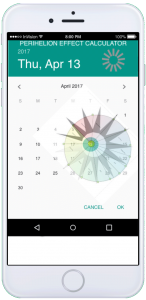The Calendar before Julius Caesar’s Calendar
Even this calendar not is important to postal historians (!) it is important to know why Julius Caesar introduced his famous “Julian Calendar” in 45 BC. We do not know exactly what happened in the many years before 45 BC but the calendar used had originally commenced in March on the date when the new consul took office. In 222 BC the date of assuming duties was fixed as March 15, but in 153 BC it was transferred to the Kalendae of January, and there it remained. January therefore became the first month of the year, and in the western region of the Roman Empire, this practice was carried over into the Julian calendar (3 – II, p 64).
The Julian Calendar
In the year of 46 BC Julius Caesar (102-44 BC) decreed a solar calendar with months at fixed lengths after the Egyptian model where one year had 365 days, 12 months and every 4th year was a leap year with 366 days. Caesar also retained 1 Januar as the beginning of the year which – as mentioned – was in troduced in the Roman calender earlier. To get the public feasts back to the correct seasons an intercalary month was inserted in the year of 46 BC which was called the “Year of Confusion” as it consisted of 445 days – and on 1 January 45 BC the Julian Calendar came into effect. (3 – II, pp 75).
Around the year 527 AD, Dionysus Exiguus suggested counting the years from the “birth of Jesus Christ” on 25 December 753 AUC (Ab Urbe Condita, i.e. since the founding of Rome), making the current era start with 1 AD on 1 January 754 AUC. This means that the 1st millennium cover the years 1-1000, 2nd millennium the years 1001-2000 and the 3rd millennium the 2001-3000 (w1). (Happy New Millennium on 2001.01.01 🙂
The tradition that the vernal equinox should be fixed to a particular date (21 March), harks back to the first official council of the Christian Churches in 325 AD, at Nicaea. The mean Julian year had 365.25 days; i.e. (365*3 + 366)/4. This actually was a bit over-estimated – and led to the vernal equinox slipping by about a day every 130 years during the Julian calendar period from 325 AD to 1582 AD (w2).
The Gregorian Calendar
To avoid this increasing difference between date and Equinox Pope Gregorius XIII (with the help of the astronomer Christopher Clavius (1537-1612)) in 1582 declared that the day after 4 October 1582 should be 15 October 1582 and then Equinox again would fall on 21 March. Furthermore the rule for leap years (which said that years divisible with 4 should be leap years) was changed so that years, at the end of the century, should be leap years only if they were divisible with 400 (e.g. 1600, 2000, 2400 etc.).
The papal bull was dated “Anno Incarnationis Dominicae M. D. LXXXI.” (In the year of the Incarnation of the Lord 1581 which is the year beginning March 25, 1581 and which corresponds to 1582 in our current year reckoning.)
Contrary to popular belief, the papal bull did not mandate any particular date as the start of a new year.
In the Gregorian Calendar there is then 303 years with 365 days and 97 years with 366 days, which gives a mean year of 365.24250 days: 365 days, 5 hours, 49 minutes and 12 seconds. Related to the mean interval between vernal equinoxes this corresponds to a slippage of less than one hour in every 300 years for the foreseeable future – until circa 4000 AD (w2).
To convert from the Julian to the Gregorian calendar:
From 5 October 1582 JU – 28 February 1700 JU: Gregorian dates = Julian dates + 10
From 29 February 1700 JU – 28 February 1800 JU: Gregorian dates = Julian dates + 11
From 29 February 1800 JU – 28 February 1900 JU: Gregorian dates = Julian dates + 12
From 29 February 1900 JU – 28 February 2100 JU: Gregorian dates = Julian dates + 13
(Not 2000 JU because of the Gregorian leap year in 2000)
The Calendar Reform in Various Countries
The Gregorian Calendar was introduced at different times at different places. The following three schemes lists countries where I have found sources showing calendar changes from Julian to Gregorian calendar. For postal historians information on calendar changes before 1700 (Julian or Gregorian time) is not especially relevant because there – to my knowledge – do not exist letters from one country with Julian Calendar to another country with Gregorian Calendar – or vice versa – where you are able to see different datings due to the different calendars. At least are such letters not in the hands of collectors. Anyway, it is my hope that you can use some of the information listed.
You should be aware of the fact that some major sources, like (5), say that the Gregorian Calendar was introduced in England in 1753 while other major references, like (4), say 1752, depending on what the changes should have been made before a source say that the shift has taken place. England left out 10 days in september 1752 and this is what this document is concerned about: when the leaving out of the days took place for a certain country/area. So even England “at last introduced the Gregorian calendar by changing the calculation of the easter in the Gregorian way” (5), this document still list the change over in september 1752.
Earlier Calendar Reforms
You must be aware that the territorial division of Europe has changed a lot since the Gregorian Calendar was introduced in 1582. Territories that existed those days do not exist any more, others have changed considerably, and so on. Especially, Germany and Italy used to be a patchwork of bigger and minor states. For Germany you can roughly say that the Catholic territories adopted the Gregorian Reform in the 16th century already whereas the Protestant territories only followed in the 18th century. The situation in Switzerland was similar. Below I have listed information on the Calendar Reform where older territories are placed under the modern states they belong to nowadays – thanks to Manfred Kiefer.
Version 2000.02.29 – By Toke Nørby



